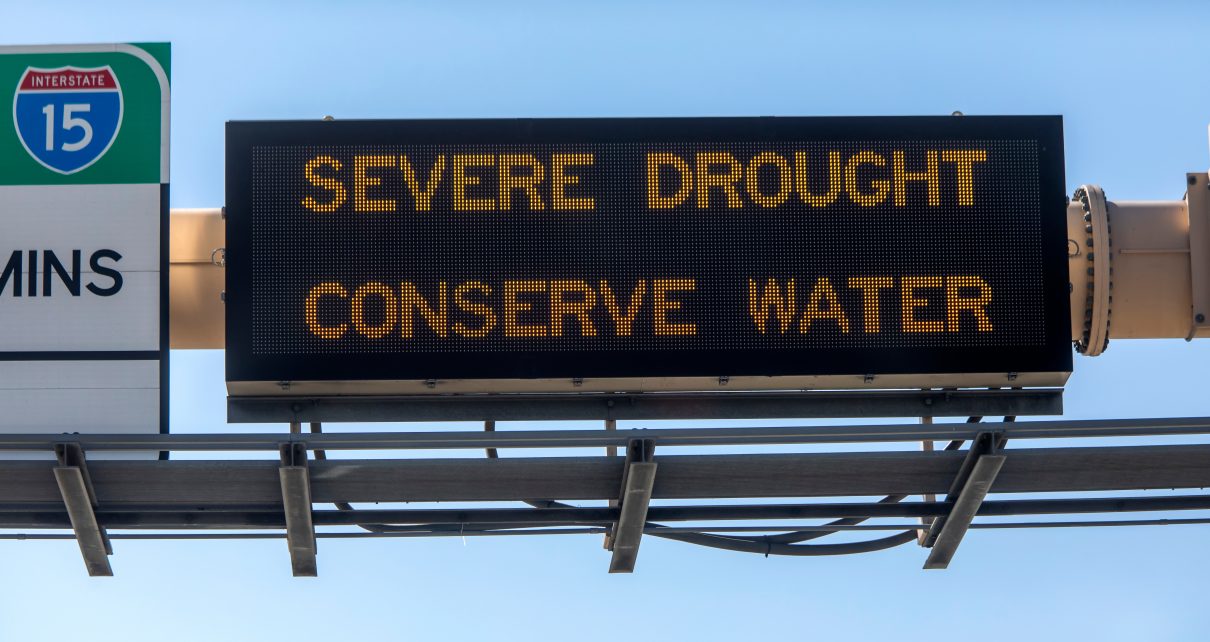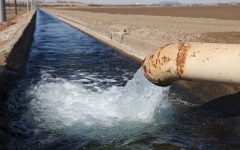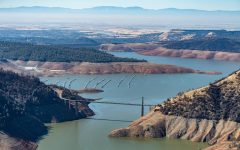
A freeway sign urges residents to conserve water amid a severe drought. (Photo: F Armstrong Photography/Shutterstock)
California Holds the Key to Western Water Security
More water from new sources is required, and the only place that is possible is California
By Edward Ring, May 9, 2023 9:00 am
Dams and aqueducts on the Colorado River make civilization possible in the American Southwest. But for the last 20 years, as a prolonged drought has gripped the region, withdrawals from the river have averaged 15 million acre-feet per year, while inflows into Lake Mead and Lake Powell have averaged only 12 million acre feet per year.
For the first time since these reservoirs were built nearly a century ago, the relentlessly escalating quantity of water demanded by the cities and farms of the Southwest, combined with years of drought, have brought the levels of remaining water to dangerous and unprecedented lows. As of May 8, 2023, only 7.7 million acre feet (MAF) remains in Lake Mead, and only 5.8 MAF remains in Lake Powell.
Despite months of negotiation, the seven states that draw water from the Colorado River have failed to come to an agreement on how to adapt to its dwindling flow. The current deadlock pits California against the other six states – Wyoming, Colorado, Utah, New Mexico, Nevada, and Arizona. But if they had the political will, California could solve the whole problem for everyone.
The Federal Bureau of Reclamation, which operates these massive reservoirs, has the option to impose its own solution if an agreement isn’t reached between the states. Starting this year, it has called for overall annual withdrawals to be reduced by 2 to 4 million acre feet. In the short run, one way or another, this goal will be achieved. But in the long run, more water from new sources is required, and the only place that is possible is California.
Chronic water scarcity in general, and the Colorado crisis in particular, underscores California’s grotesque failure to upgrade its water infrastructure for the 21st Century. The last big dam in California was built in 1980, part of a remarkable system of reservoirs and aqueducts constructed mostly in the 1950s and 1960s. But since 1980 California’s population has grown from 23 million to nearly 40 million, and its neglected water infrastructure is no longer sufficient.
Since 1980, Californians have endured five droughts. The response of California’s state legislature has been to emphasize conservation over construction of more water supply infrastructure. And to-date that response has been adequate, assuming you’re ok with indoor water rationing, mandated “water efficient” appliances that cost too much, don’t last very long, and don’t work very well, no more outdoor landscaping, and millions of acres of intermittently fallowed farmland.
With policies like this, it comes as no surprise that California’s politicians are predicting even worse droughts in the future. They refuse to make any significant investments in water supply infrastructure. But conservation alone has reached the practical limit of its benefits. With groundwater aquifers dangerously depleted and access to Colorado River water imperiled, rationing isn’t going to be enough.
The good news is that with smart investments in new infrastructure, water abundance is possible in California even in dry years. Its 2021-22 water season had some of the lowest total precipitation on record. But during the month of December, 2021 well over 100 million acre feet of rain fell during the one big storm that hit the state that year. If California had the capacity to capture more of that water, it would have been enough. As it is, during this current water season, one of the wettest on record, politicians continue to warn Californians that “the drought isn’t over.”
What California can rely on, unlike anywhere else in the American Southwest, are these so-called atmospheric rivers that saturate the state with enough rain to easily supply farms and cities with adequate water. Even in drought years, one or two of these storms blow in from the Pacific, hit the ramparts of the Sierra Nevada Mountains, and dump tens of millions of acre feet of runoff into the streams and rivers. Californians can, and must, agree on new infrastructure solutions that will safely harvest more of this water for human consumption.
Balancing the needs of ecosystems with the needs of civilization is never easy, but there are two major projects that could unlock millions of acre feet of new water for Californians. The first is to eliminate the nutrient pollution in the San Francisco Bay. Lining the Bay and its estuaries are 37 urban wastewater treatment plants. Their discharge, cumulatively totaling nearly a half-million acre feet per year, is clean, but still has a nutrient load that leaves the waters of the Bay vulnerable to toxic algae blooms. Feeding on the nutrient rich water, in July 2022 one of these blooms, the largest in recorded history, spread through much of the San Francisco Bay, creating a dead zone that persisted for months and killed millions of fish including endangered salmon and sturgeon.
For an investment of around $12-$15 billion, these water treatment facilities could be upgraded to eliminate nutrient pollution. The solution to-date has been to dilute the nutrient loads in the Bay by requiring massive flows from the Sacramento-San Joaquin Delta. If that was no longer necessary, more water could be withdrawn from the Delta for California’s farms and cities even in dry years. On average, tens of millions of acre feet flow through the Delta each year during storms that could be diverted and stored if there were a safe way to do so.
There are plenty of ways Californians can develop new ways to extract and store water from the Delta during atmospheric river events. A new proposal calls for constructing channels in some of the Delta Islands and installing huge perforated pipes under a gravel bed. By decentralizing the water withdrawals with many of these installations, fish would be protected. This water could be rapidly transferred to aquifers south of the Delta via newly discovered underground flumes that would permit rapid injection. Unused aquifer capacity in the San Joaquin Valley is conservatively estimated at over 50 million acre feet.
Other ways that Californians could harvest more water are as well documented as they are neglected. Build more reservoirs. Collect, treat and store more storm runoff in urban areas. Recycle and reuse 100 percent of wastewater in urban areas. Build desalination plants on the California coast. Upgrade and expand California’s network of aqueducts, pipelines and pumping stations, so that every year, millions of acre feet of safely harvested water could supply not only San Joaquin Valley agriculture, but also Imperial Valley agriculture.
This is how California can give back not only its share of Colorado River water, but cover the entire 2-4 million acre foot deficit. Other states in the Colorado Basin might help fund these projects. California’s state legislature has an opportunity to solve forever the challenge of water scarcity in the American Southwest. Doing so would be consistent with the spirit that built this state; a spirit that embraces freedom and prosperity, and turns dreams into reality.
- Ringside: Will Advocates for More Water Supply Projects Find Unity? - December 11, 2025
- Ringside: EVs and California’s Future Demand for Electricity - December 4, 2025
- Ringside: Politically Viable Water Supply Projects - November 27, 2025





Maybe Kevin can carry the pail now.
Tom carried it for a long time, but now he has been branded evil by the MSN
Better yet, get a Dem with some common sense to carry this pail, if one exists.
All of these practical,solutions would be wonderful, but then how would the CCP be able to buy up the bankrupt CA farmland on the cheap at the bankruptcy sales? /s
Newsom needs those campaign contributions to mount his Presidential run and fulfill his WEF obligations as a “Young Global,Leader”…